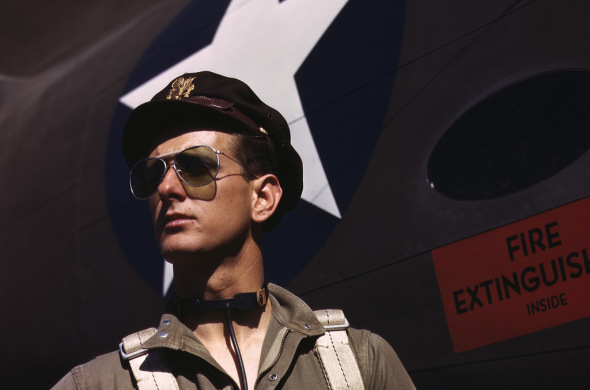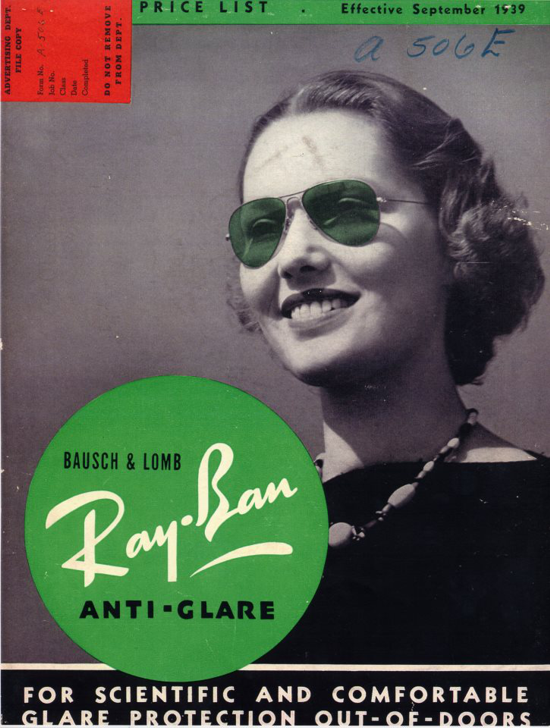1930s: Where it all took flight
Born in the skies, built for the brave — the Aviator takes off and the Ray-Ban legacy begins.
The Spark of Innovation


From Utility to Style
Although Ray-Ban’s aviator shades were created for U.S. Army Air Corps pilots in 1937–38, they didn’t stay in the cockpit for long. The Aviator quickly caught the public’s eye as a symbol of adventure and modernity. By the late 1930s, senior military officers, competitive marksmen, and style-minded civilians were adopting mirrored lenses and teardrop frames, drawn by their precision engineering and the swagger they implied.
Bausch & Lomb’s early marketing leaned into that prestige. A 1938 campaign proclaimed “Champions and Leaders wear Ray-Ban Anti-Glare”, pairing the glasses with aviation champions and record-holding shooters. This was the birth of the “cool factor” — positioning Ray-Ban not merely as protective gear, but as the choice of those at the top of their game.
Even without Hollywood’s help, real-world figures in aviation and sport were elevating the brand. Photographs of air race winners, military demonstration teams, and sportsmen in Ray-Bans appeared in newspapers and magazines, giving civilians a glimpse of a high-performance world they could buy into.
By the close of the decade, Ray-Ban “sun glasses” had shifted from specialist equipment to a coveted accessory — still carrying the grit and precision of the airfield, but increasingly worn on the street as a marker of modern style.
The Original Sell: Function Meets Form
1937: Bausch & Lomb launched Ray-Ban as an “Anti-Glare” aviator goggle for U.S. Army Air Corps pilots. The Ray-Ban trademark was registered and the first Ray-Ban advertisements appeared that year. Early marketing centered on the Aviator sunglasses’ military origin and practical benefits—reducing blinding sun glare for pilots—while introducing a touch of style.
Print ads in aviation magazines and newspapers highlighted the new Ray-Ban Aviator name (adopted instead of the generic “anti-glare” label) and positioned the glasses as cutting-edge gear for heroes of the sky. This creative direction established Ray-Ban’s aspirational tone, associating wearers with daring pilots and adventure.
1938: Ray-Ban expanded its lineup with the Ray-Ban Shooter, a variant tailored to sport shooters and hunters . Marketing for the Shooter emphasized its technical innovations: choice of green or yellow lenses to enhance detail by filtering specific light (useful in hazy conditions) and a distinctive “cigarette holder” circle on the bridge allowing hands-free use. Print advertisements and product catalogs targeted outdoorsmen, touting how the Shooter combined utility (glare reduction) with rugged style. The messaging highlighted the brand’s responsiveness to niche needs (marksmen and outdoor sports) while maintaining the Aviator’s cool factor.
1939: Building on the outdoors theme, Ray-Ban introduced the Outdoorsman (originally called “Skeet Glass”), aimed at fishing and hunting enthusiasts. This model’s marketing stressed its added features like leather-wrapped brow bars and temple tips for comfort and sweat absorption.
Bausch & Lomb’s ads in the late 1930s often showed men in outdoor attire or military uniforms wearing Ray-Bans, reinforcing a premium, adventure-ready image. By the end of the decade, Ray-Ban had established a reputation not only for functional eyewear trusted by pilots and sportsmen, but also as a symbol of rugged American glamour that anyone could don to emulate those heroes.